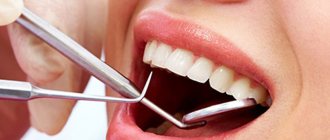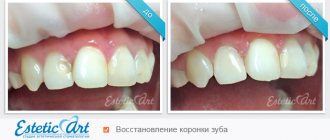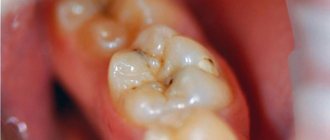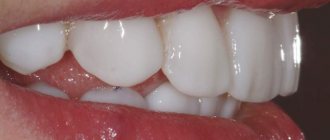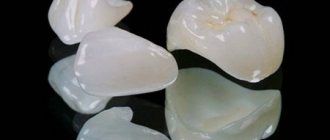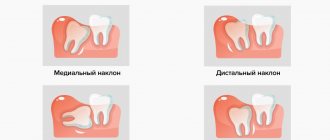Chips and tooth decay, stains on enamel, caries - all these problems cause physical and psychological discomfort. If you are forced to hide your smile, then you should pay attention to the dental restoration service in Chelyabinsk. The work of a dentist in the aesthetic field is similar to the work of a sculptor or artist - to choose the right shade, restore the correct anatomical shape and functional load of the tooth, in a word - to create a real masterpiece.
At your first appointment at the dental clinic, the doctor will perform an examination and diagnosis, select a method of teeth restoration and inform you about the price of dental restoration.
Price
Anesthesia - 450 rub.
Restoration of one tooth costs from 3,700 to 5,500 rubles, depending on the degree of destruction.
If it is necessary to use a pin, it is added to the cost.
The cost of the anchor pin is 1000 rubles.
The cost of using a fiberglass pin is 1,900 rubles. - everything is added according to the price.
Veneer installation - from RUB 15,000
Installation of composite veneers - from 12,000 rubles
You can find out more about prices on our price list page.
Types of artistic restoration
Direct method
For minor dental defects, direct dental restoration is performed. This method makes it possible to solve the problem in just 1 visit.
Stages of work:
- Diagnosis - determining the volume and choosing the ideal treatment method;
- Professional cleaning of the oral cavity - to determine the color of the photopolymer;
- Administration of anesthesia - ensuring maximum patient comfort during the procedure;
- Preparation - to create more gentle conditions immediately before the procedure.
- Isolation of the tooth restoration site provides protection from moisture, which negatively affects the adhesion of the filling surfaces and tooth enamel.
- Treatment procedure.
To restore a tooth, a modern material base is used, which is highly resistant to external factors. One of the popular materials is photocomposite. It is convenient to work with, it has good strength indicators, and is perfectly matched by color.
Photos BEFORE and AFTER
Advantages and disadvantages of the direct method
Pros of the procedure:
- Carrying out the procedure with minimal treatment of the dental space. This is a more “softened” regime for the oral cavity, including tooth enamel.
- The adhesive properties of the components used as a seal provide a guarantee for a very long service life.
- If high-quality photocomposite components were used during the work, the restored tooth will serve you faithfully for many decades.
- Speed (possibility of defect restoration in one visit).
- High quality (the shape of the lost part of the tooth is completely restored).
- Durability.
Disadvantages of the procedure:
- The main disadvantage of this method of restoration is that all stages of work are carried out directly in the oral cavity.
- Often the procedure causes a number of uncomfortable sensations in patients, as well as a number of inconveniences for the attending physician.
But the dentists of our clinics will restore the tooth so that from the outside it will be no different from your own teeth.
Indirect (external) recovery
The method received its second name because most of the tooth formation is carried out outside the oral cavity. The material for the production of new teeth is a veneer (a structure made of a porcelain or composite thin plate that does not cover the entire tooth, like crowns, but only its front part). It has high indicators: durability, aesthetics, durability, ease of use and a quick period of adaptation. Most often, veneers are used for external tooth restoration.
The use of veneers has several more undeniable advantages:
- The process of their manufacture is carried out in a specialized laboratory complex using an impression, which is made by our dentist individually for each patient. This ensures perfect contact with adjacent teeth without additional grinding.
- The wear resistance of ceramic components is much higher than that of photocomposite components. Naturally, the service life will be significantly longer.
- The retention time for the set color shade is almost the same. The difference is determined only by the patient’s subsequent care for the oral cavity and compliance with the rules and standards of hygiene.
- Due to higher adhesive properties, the filling material outperforms veneers. The latter sometimes tends to peel off, possibly causing microcracks.
Composition of veneers
A veneer is a thin plate made of ceramic or composite material. Due to its high aesthetic performance, ceramics are ideal for the aesthetic dentistry industry. There are a great variety of options for selecting color shades similar to natural tooth enamel. When installing veneers, it is only possible for an experienced dentist to determine its presence and distinguish it from a natural tooth. This undeniable advantage of veneer is highly appreciated by our clients. Veneers guarantee high aesthetics, including a beautiful smile.
Veneer material is completely harmless to the oral cavity, as it does not cause any harm to tooth enamel due to the absence of metal impurities.
Defects eliminated by indirect tooth restoration
With the help of indirect tooth restoration, you can correct the most severe damage: from interdental gaps of any size to serious carious processes.
Aesthetic dentistry is a new section of dentistry that has received active development in the last ten to fifteen years. Today, this area is invariably in great demand among patients because it allows one or more teeth to be corrected or restored and, therefore, helps the patient achieve a beautiful smile.
Artistic restoration or composite restoration is restoration using restoration materials (composites) that allow you to most accurately imitate the texture of a tooth (color, transparency, shine, etc.), while the technology involves gentle preservation of your own healthy tooth tissues.
The reasons why artistic restoration is most often resorted to:
- improve tooth color, eliminate darkening, stains, uneven color;
- restore the shape of the tooth at the site of a chip or other defect;
- get rid of wide interdental spaces in the smile area;
- correct an incorrect or different shape, size, or contour of a tooth.
Reasons for changes in the appearance of teeth:
- lack of daily care or improper oral care;
- various diseases of the oral cavity: caries, pulpitis, periodontitis, etc.;
- various dental injuries (cracks, chips);
- excessive consumption of coffee or strong tea;
- bad habits (smoking);
- taking medications that cause changes in enamel color;
- enamel fluorosis due to excessive intake of fluoride into the body with water.
How is artistic dental restoration carried out at the Medix Clinic?
Our dentists use modern composite materials from leading global manufacturers. Composites perfectly imitate the structure of hard tooth tissues. Moreover, the doctor selects the color and transparency of the composite in accordance with the tooth enamel. Our specialists recreate the anatomical shape of the tooth amazingly accurately, imitating all the cusps and fissures.
It is worth noting that artistic restoration with composite materials is less traumatic and allows you to preserve healthy tooth tissue. And also the restored teeth are fully restored to functionality.
As a result, the patient receives a beautiful smile without chips or defects.
Other restoration methods that are available at Clinic Medix:
If it is technically impossible to restore a tooth with composite restoration alone, other more complex techniques come to the rescue. For example, if you need to restore a tooth that has been destroyed by more than 50%. Applications: installation of veneers, crowns, dentures, implants.
Veneers are a design that is a thin ceramic plate, which is made individually and fixed to the front surface of the tooth to hide defects and imperfections (chips, cracks, stains). Veneers imitate the properties of enamel as accurately as possible and are not subject to discoloration, clouding or staining.
Crowns - if a tooth is partially or completely destroyed, the best option is to install a crown. This is a kind of microprosthesis that is used when it is impossible to install a filling. Crowns are characterized by strength and durability. There are two crown options to choose from: metal-ceramic and metal-free zirconium.
Dentures are a way to inexpensively replace one or more missing teeth. There are removable and fixed dentures.
Implants are the most effective way to restore missing teeth. Installation of an implant does not affect neighboring teeth and therefore does not require grinding down healthy teeth. With this method, chewing function is completely restored. And the patient receives a reliable and durable design.
An example of artistic restoration of teeth in the smile area.
Select a dentist and make an appointment
Click on the button.
A new page will open. Select a doctor's specialty, then select a specific specialist. On the doctor’s page, you can select the day and time of your appointment and sign up for the clinic. Or leave a request by filling out a simple form. The administrator will contact you and help you select a specialist and the date and time of your appointment.
Types of pins
To increase the adhesion of fillings to tooth enamel, dentists at the Optimal Choice clinic use dental pins. They come in metal and fiberglass.
The doctor determines which pin is needed in each specific case.
The shape of the pins is:
- cone;
- cylinder;
- cylinder+cone.
Depending on the condition and “complexity” of the tooth, the doctor will select the desired shape of the pin.
Another important parameter is the degree of fixation. There are two types:
- Active pins. These include solid threaded rods. To install them, they are screwed into the dentin. This ensures maximum structural strength (used for severely damaged teeth).
- Passive pins. They are used to build teeth and for restorations. They are attached to the root canal with special dental glue.
To ensure high-quality installation of the future tooth base into the cavity space, it is necessary to carry out a number of preliminary works. Only with good preparation can the best end result be achieved. After preparing the dental canal, the medical pin is inserted and firmly fixed using adhesive materials, for example, cement mortar.
Upon completion of the procedure, modeling of the crown part of the tooth is performed. Grinding and polishing are also carried out. If necessary, our dentists perform corrective work.
Types of composite dental restoration
The dentist chooses a restoration method (veneer, inlay, filling) depending on the type of tooth being restored (front, side, chewing) and the size of the destruction.
1. Composite fillings. These are fillings made of epoxy, acrylic or photopolymer. Among such fillings, the most reliable and versatile are photopolymer ones.
2. Composite inlays. They are used by dentists in case of significant damage. Composite inlays have an ideal price-quality ratio, which explains their popularity. They are produced by the indirect method in the laboratory.
3. Composite veneers. These dental onlays have a mainly aesthetic function, hiding damage and defects. They can be produced by direct or indirect method.
Important! Our main advantage is our own dental laboratory. This means saving time and money for our patients.
Dental restoration with composite materials can be direct or indirect.
Direct dental restoration
The direct procedure is performed by a dentist by applying layers of material directly into the patient’s mouth and consists of the following steps:
1. Anesthesia.
2. Preparation of damaged areas, preparation for installation.
3. Application of composite, modeling of restoration.
4. Curing of the material under the influence of ultraviolet light.
5. Sanding.
6. Polishing.
This method is used for the restoration of anterior teeth and the restoration of minor defects in lateral teeth.
Important! The procedure lasts 1 hour per tooth.
Getting the desired shade
To give an artificial tooth a shade of color similar to a natural one, the dentist carefully selects a color from the available palette. Modern filling materials are composite and compomer.
Composite materials provide maximum adhesion to tooth enamel due to the formation of strong chemical bonds.
Compomer materials combine the positive qualities of glass ionomers (they protect the tooth) and allow you to achieve high aesthetics during filling. Due to their composition and quality characteristics, compomer materials release fluoride compounds into the tooth enamel, which further strengthen the tooth.
Prevention
Constant and proper care will help you keep your teeth safe and sound:
- Use a suitable toothpaste as recommended by your dentist.
- Brush your teeth at least 2 times a day: morning and evening.
- If you have problems with gums, increased sensitivity of enamel or lack of calcium, you need to use different products.
- Tartar should be cleaned every 6 months - this will keep the gums and enamel as healthy as possible, and also get rid of yellow plaque from coffee, tea and nicotine.
- Remember to visit your dentist at least once every three to six months.
Dental care after restoration:
- Sunflower seeds and smoking are extremely undesirable.
- Coloring foods (tea, coffee, red wine) also affect natural whiteness, and even more so during restoration...
- Restored teeth love a non-abrasive toothpaste that won't scratch. And replace toothpicks with dental floss.
- Visiting the dentist twice a year is recommended for all patients. But when restoring teeth, this has a special meaning, since it is necessary to monitor the condition of the composite material and, if necessary, polish it again.
- After restoration, subsequent professional teeth whitening is contraindicated.
Alternative to dental restoration
Braces system.
In some cases, an alternative to correcting dental defects with veneers may be orthodontic treatment. These are orthodontic fixed devices that the doctor installs on the outer or inner side of the dentition in order to straighten the teeth, correct the bite and eliminate defects.
Contraindications:
- Absence of a large number of teeth;
- Anomalies of the skeletal system;
- Oncology;
- Endocrine and immune diseases;
- AIDS;
- Psychological disorders and diseases.
Nowadays, even after 22-25 years, correcting the bite using this method is effective, although it is better to do this before the age of 16-18.
The advantages of braces made from different materials vary.
Metal
- Durable;
- Reliable;
- Durable;
- Corrosion resistant;
- Reasonable price.
There is only one drawback - visibility.
Ceramic
- Aesthetics,
- Sufficient margin of safety;
- Resistant to food coloring;
- Long service life;
- Hypoallergenic.
Cons: relative fragility.
Basic methods of artistic dental restoration
Depending on the problem and condition of the teeth, the dentist selects the most optimal method of restoration:
Restoring the appearance of teeth using filling materials
Modern fillings made from light composites are not at all similar to those of 20 years ago. They allow not only filling carious cavities, but also restoring teeth. At the same time, the teeth look absolutely natural. In addition, this type of restoration is carried out in one visit, including for several teeth. The procedure is relatively inexpensive, but is not suitable for complex cases where the tooth is severely damaged.
Dental restoration using veneers
Veneers are thin ceramic plates that can be used to quickly restore the smile area. The procedure for installing veneers is simple and painless.
Veneers differ in material and manufacturing method. Plates made from light-curing materials can be manufactured and installed directly at the dentist’s appointment. But veneers made from press ceramics are stronger, but take longer to make: first, the orthopedic dentist takes impressions, from which the veneer is made in the laboratory, then the doctor installs them on the teeth.
Before restoration with veneers
After restoration with veneers
Restoring teeth using crowns
Crowns made of ceramics and metal-ceramics are one of the most common types of prosthetics. This method is used in difficult cases when the tooth is severely damaged. Crowns are durable, strong, hygienic and resistant to high chewing loads. However, crowns are not recommended for gum disease, and the materials they are made from can cause allergic reactions.
Before installing metal-free ceramics
After installation of metal-free ceramics

